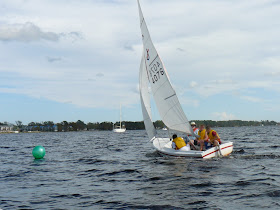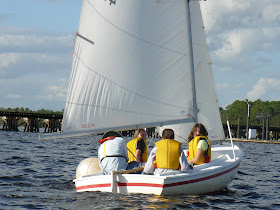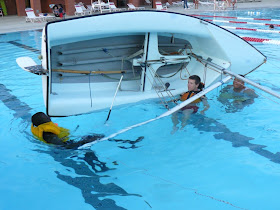
. . Here we GO!
Everybody got a chance to sail one of our Javelin sloops this afternoon. Winds were light, but most of the time the boats kept moving right along.
Here are 2 fledglings leaving the nest... umm, dock...
So far we have learned some basic terminology, names of parts of the boat, and practiced capsizing in the FJ... actually, the capsize lesson gave us a good familiarity with how small boats behave (or mis-behave) on the water.
This sense of coordination & familiarity is very important to learning the next steps... how to take control of the boat & make it go where you want!
.
.

Today, the green buoys were anchored at the windward side of our sailing area. Here is a cadet skipper & crew sailing up wind (how is that possible? link)... obviously they have made good progress under the eye of Coach Jackson.
.

Here is our recently donated Javelin, given to us by the son of the late Jimmy Cox of Trent Woods. Mr. Cox was a Navy veteran of World War 2 and loved to sail.
These cadets with Coach Murphy are doing well... the boat is close-hauled (going upwind) and weight is centered, jib & main are trimmed properly for this Point Of Sail.
.

OK, one more close-hauled pic... here's our original Javelin, the USS Craig-Bob, with Coach Dillinger relaxing. Looks a little stern-heavy but the tiller is straight & the sails are full., boat is moving.
.
By now, all sailing cadets should have their textbooks and their first assignment. Today we practiced sailing on several Points Of Sail, steering with the tiller, and tacking... all these things must be mastered before moving on to the next skill level. The text should explain today's practice and help get us ready for actual sailing drills!

What's wrong with this picture? Who's not wearing a life jacket?!?
Actually, we do not currently have enough life jackets SO for now, some of these cadets have permission to not wear PFDs.
Here is Coach Cornford teaching knots & rope skill to the cadets who were not in the first group of Javelin sailors.
.

But they DID get to sail! Here's Coach Jackson again, with his 2nd group of sailors.
This Javelin was donated by the Myers family of Pennsylvania
Here's another safety rule- long hair should be tied back, it is too easy to get caught in lines or blocks... makes a great indicator for wind direction though!
BTW what about SHOES ??!?
.

This boat is moving well, not surprising because it has 2 experienced cadets sailing it now!
.

Coach Dillinger says, "Steer the boat toward that green buoy, come close but don't hit it."
Piece of cake, right?
In the background you can see the two orange buoys which were anchored at the leeward (downwind) side of our sailing area.
.

OK, we've done the sailing thing... what happens when 2 boats get close together? There are a set of 'Right-Of-Way' rules to guide boats around each other safely.
These 2 Javelins are ON the same TACK (being "on a tack" is not the same thing as "tacking" sorry)... note the jibs on the same side of the mainsail... so what rule(s) should they follow to avoid a collision?
That was not part of today's lesson BUT it is part of the upcoming lesson(s). Think ahead!
Review- By now, we should know basic boat parts (which one is the SHEET, which one is the HALYARD); we should know some boat procedures including boarding & capsize procedure, 3 knots (bowline, figure-8, cleat hitch), how to steer with a tiller, how to set the sails, and how to steer & adjust the sails in combination for the different POINTS OF SAIL, and how to TACK.
Next week we will build on all this knowledge & all these skills; hopefully we can begin the basic sailing drills... remember we have only 9 sailing sessions through the fall. This class is learning quickly and has much to be proud of, but we also have a long way to go!
... posted by Assistant Coach Doug King































